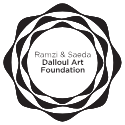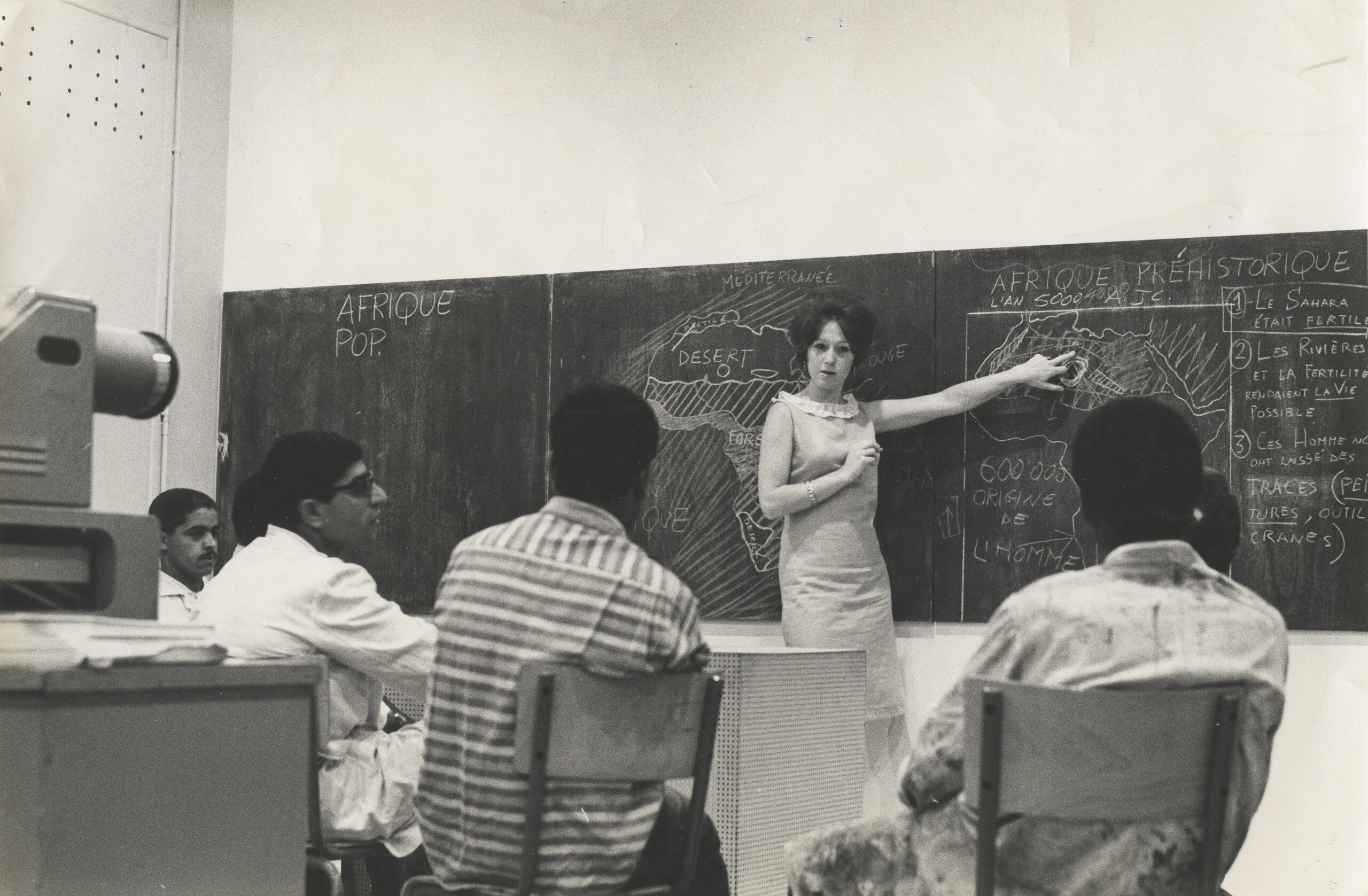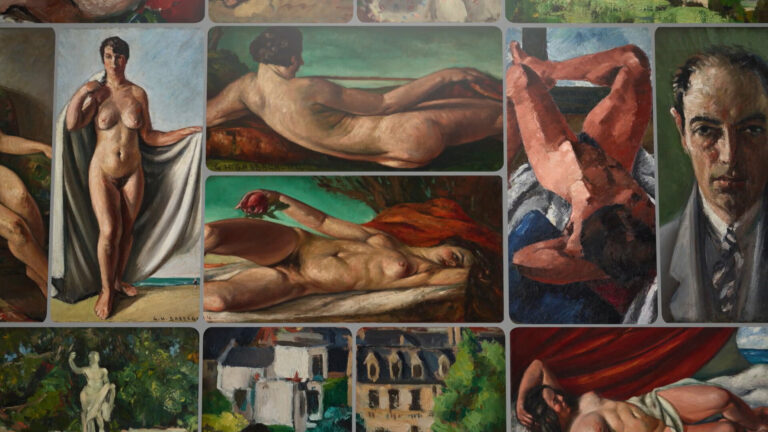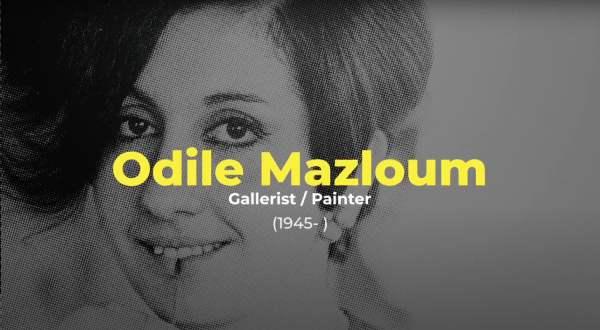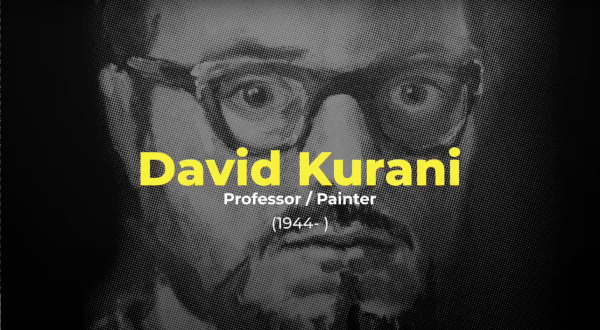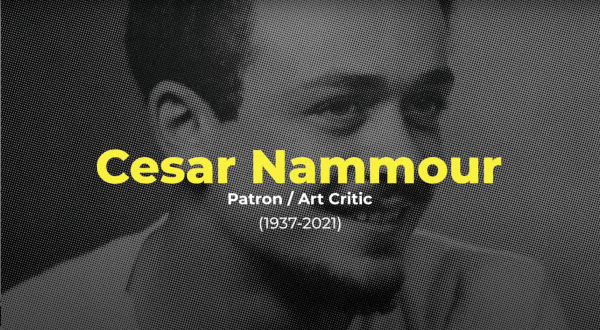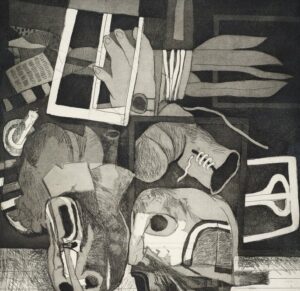ART TALKS
Check out some of DAF's latest Arab Artist Biographies
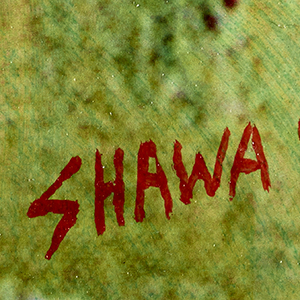
Laila Shawa
Laila Shawa was born in 1940 to a wealthy Gazan family. As a child, she was curious about art, but per her own description, her career as an artist started with a happy coincidence. In the mid-1950s, she was enrolled in the American University of Cairo as a student of political science and sociology when she had tea with her father and a family friend. Read More >>
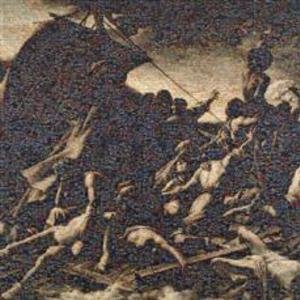
Kader Attia
Born in the Parisian suburb of Seine-Saint-Denis, France, in 1970 to an Algerian family originally from the mountainous areas around the Algerian city of Constantine, Kader Attia grew up between two countries and cultures. He studied at the École Supérieure des Arts Appliqués Duperré and the École Supérieure des Arts Décoratifs both in Paris. Read More >>
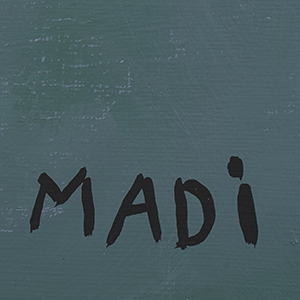
Hussein Madi
Hussein Madi was born in Chebaa, a town on the southeastern tip of Lebanon, in 1938. He spent his summers following his paternal grandfather into the orchards, observing him perform with talent, diligence, and mastery of his daily farming, carpentry, or blacksmith chores. From his stoic and wise grandfather Read More >>
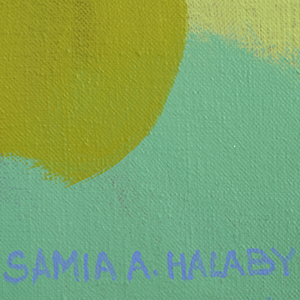
Samia Halaby
A leading abstract visual artist, Samia Halaby, was born in 1936, in Jerusalem, Palestine. Halaby and her family relocated to Lebanon during the Nakba, Palestinian exodus in 1948. By then, most of the Palestinian land was occupied, and the Israeli state was declared.
Read More >>
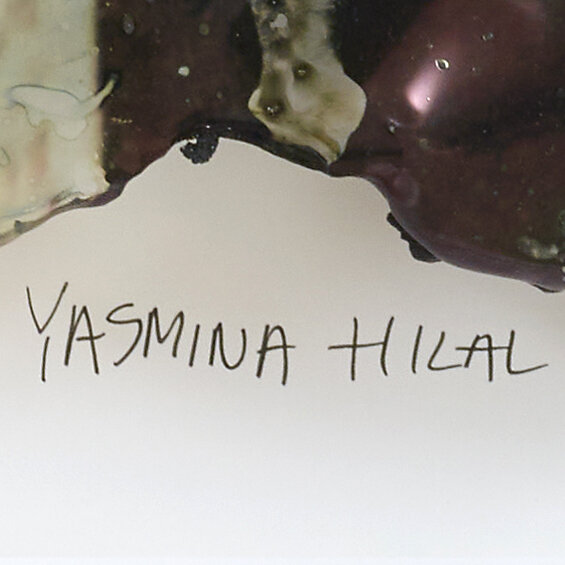
Yasmina Hilal
Yasmina Hilal was born in Beirut, Lebanon in 1996. She is a Lebanese-American collage artist and photographer, whose work is influenced by and concerned with fashion. This is no surprise, considering that her grandmother owned a clothing store in Beirut called Beverly Hills, in the 1960s. Read More >>
Olive Tree Grove, 2012, by Palestinian artist Sliman Anis Mansour is a dreamlike depiction of rolling hills of olive trees that stretch to the horizon and beyond. This artwork highlights the nostalgia for an idealized Palestinian pastoral landscape that is untarnished by the occupation and its urbanization.
The olive tree is a constant motif across many Arab artists’ works because of the weight its symbolism carries as a reflection of resistance and resilience. It is a claim to the land that was inherited across generations and represents the preservation of cultural heritage.
In Tagreed Dargouth’s piece from her series “The Tree Within, A Palestinian Olive Tree”, 2018, the dynamic brushstrokes give the work a sense of urgency and fervor. The familiar gnarled trunk is deeply grounded in the soil, a symbol of steadfastness, while blood-red droplets trickle through its roots.
Olive Tree Grove, and The Tree Within,A Palestinian Olive Tree, are part of ‘Marhala Part 2,’ showcasing highlights from the Dalloul Collection at Christie’s Modern and Contemporary Middle Eastern Art Auction in London on 31 October 2024. The online auction will be open until 4 November.
Sliman Anis Mansour
Olive Tree Grove, 2012
Medium: Oil on canvas
106 x 106 cm
Tagreed Dargouth
from the series "The Tree Within, A Palestinian Olive Tree", 2018
Medium: Acrylic on canvas
200 x 150 cm
#DAFBeirut #ArabArt #ArabArtists #Beirut #Lebanon #Palestine #ArtandWar
Oct 23

Olive Tree Grove, 2012, by Palestinian artist Sliman Anis Mansour is a dreamlike depiction of rolling hills of olive trees that stretch to the horizon and beyond. This artwork highlights the nostalgia for an idealized Palestinian pastoral landscape that is untarnished by the occupation and its urbanization.
The olive tree is a constant motif across many Arab artists’ works because of the weight its symbolism carries as a reflection of resistance and resilience. It is a claim to the land that was inherited across generations and represents the preservation of cultural heritage.
In Tagreed Dargouth’s piece from her series “The Tree Within, A Palestinian Olive Tree”, 2018, the dynamic brushstrokes give the work a sense of urgency and fervor. The familiar gnarled trunk is deeply grounded in the soil, a symbol of steadfastness, while blood-red droplets trickle through its roots.
Olive Tree Grove, and The Tree Within,A Palestinian Olive Tree, are part of ‘Marhala Part 2,’ showcasing highlights from the Dalloul Collection at Christie’s Modern and Contemporary Middle Eastern Art Auction in London on 31 October 2024. The online auction will be open until 4 November.
Sliman Anis Mansour
Olive Tree Grove, 2012
Medium: Oil on canvas
106 x 106 cm
Tagreed Dargouth
from the series "The Tree Within, A Palestinian Olive Tree", 2018
Medium: Acrylic on canvas
200 x 150 cm
#DAFBeirut #ArabArt #ArabArtists #Beirut #Lebanon #Palestine #ArtandWar
...
`Palestinian artist Kamal Boullata’s, La Ana Ila Ana (There is No I But I), 1983, is heavily inspired by his exploration of Islamic art and calligraphy. The Kufic script used in this work is one of the oldest forms of Arabic calligraphy, known for its angular, geometric style, which blended seamlessly with the abstract geometry that characterizes much of Boullata’s art.
The Kufic script became central to Boullata’s work, particularly through his involvement with the Hurufiyya Movement – a mid-20th-century art movement that sought to integrate Islamic calligraphic traditions with modern abstract art.
Printmaking allowed Boullata to explore the intersection of Islamic and Byzantine aesthetics while engaging with his visual and verbal memory. His artworks, often appearing as part of larger groups or series, are characterized by their orderly, composed nature, where color fields, letters, and lines are set into complex relationships.
Click on link in bio for Prints & Printmaking exhibition’s virtual tour.
La Ana Illa Ana, 1983
Medium: color silkscreen on paper
Edition Number: 16/30
76 x 56 cm
#DAFBeirut #ArabArt #ArabArtists #Printmaking #Prints #PrintsandPrintmaking #Beirut #Exhibition
Oct 23

`Palestinian artist Kamal Boullata’s, La Ana Ila Ana (There is No I But I), 1983, is heavily inspired by his exploration of Islamic art and calligraphy. The Kufic script used in this work is one of the oldest forms of Arabic calligraphy, known for its angular, geometric style, which blended seamlessly with the abstract geometry that characterizes much of Boullata’s art.
The Kufic script became central to Boullata’s work, particularly through his involvement with the Hurufiyya Movement – a mid-20th-century art movement that sought to integrate Islamic calligraphic traditions with modern abstract art.
Printmaking allowed Boullata to explore the intersection of Islamic and Byzantine aesthetics while engaging with his visual and verbal memory. His artworks, often appearing as part of larger groups or series, are characterized by their orderly, composed nature, where color fields, letters, and lines are set into complex relationships.
Click on link in bio for Prints & Printmaking exhibition’s virtual tour.
La Ana Illa Ana, 1983
Medium: color silkscreen on paper
Edition Number: 16/30
76 x 56 cm
#DAFBeirut #ArabArt #ArabArtists #Printmaking #Prints #PrintsandPrintmaking #Beirut #Exhibition
...
Moroccan artist Farid Belkahia’s series of seven digital prints, L`Arbre À Palabres (The Palaver Tree), 2010, were inspired by Syrian poet Adonis’ book L’arbre est un poème écrit par la nature. Influenced by North African cultural roots, Belkahia named this series after the Palaver tree, traditionally a site for communal gatherings and storytelling.
Belkahia`s exploration of local artistic traditions extended to experimenting with henna, tattoos, tanning, jewelry, and pottery. His ventures into printmaking fit into his broader oeuvre of experimental, tactile art, and decolonial practices meant to make art more accessible to a larger Moroccan audience.
Explore these works at the Prints & Printmaking exhibition.
Click the link in bio for the virtual tour.
L`Arbre À Palabres (Part of a case of 7 digital prints on Bamboo Hahnemühle 290g paper, 1 original pastel and watercolor painting, and a poetry book by Adonis), 2010
Medium: Digital print of pastel and watercolor painting, on Bamboo Hahnemühle 290 g paper.
Edition Number: 26/35
29 x 34 cm
#DAFBeirut #ArabArt #ArabArtists #Printmaking #Prints #PrintsandPrintmaking #Beirut #Exhibition
Oct 21

Moroccan artist Farid Belkahia’s series of seven digital prints, L`Arbre À Palabres (The Palaver Tree), 2010, were inspired by Syrian poet Adonis’ book L’arbre est un poème écrit par la nature. Influenced by North African cultural roots, Belkahia named this series after the Palaver tree, traditionally a site for communal gatherings and storytelling.
Belkahia`s exploration of local artistic traditions extended to experimenting with henna, tattoos, tanning, jewelry, and pottery. His ventures into printmaking fit into his broader oeuvre of experimental, tactile art, and decolonial practices meant to make art more accessible to a larger Moroccan audience.
Explore these works at the Prints & Printmaking exhibition.
Click the link in bio for the virtual tour.
L`Arbre À Palabres (Part of a case of 7 digital prints on Bamboo Hahnemühle 290g paper, 1 original pastel and watercolor painting, and a poetry book by Adonis), 2010
Medium: Digital print of pastel and watercolor painting, on Bamboo Hahnemühle 290 g paper.
Edition Number: 26/35
29 x 34 cm
#DAFBeirut #ArabArt #ArabArtists #Printmaking #Prints #PrintsandPrintmaking #Beirut #Exhibition
...
Homage to Mahmoud Darwish series, 1976-1980, of silkscreen prints with watercolor, by Jordanian artist Mona Saudi, reflects her sculptural style with its distinct geometric lines and curving, plus organic forms that evoke the themes of growth, land, and identity, similar to those in Darwish`s poetry.
Song to the Green, 1977 exemplifies these elements through its flowing lines, symbolic use of natural motifs, and integration of handwritten Arabic calligraphy, resonating with Darwish’s themes of connection to the homeland.
Other notable pieces in this series include The Lover’s Tree, 1977, one of the first ones Saudi made, which highlights the unification of man and earth and was inspired by Darwish`s poem written after the suicide of his friend, poet Rashid Hussein.
The series pays homage to Darwish`s poems and demonstrates Saudi`s ability to transform poetic language into visual forms, capturing the lyrical quality of his verses through intricate line work and delicate textures.
Explore Mona Saudi’s prints at the Prints & Printmaking exhibition through our Virtual tour (Link in bio)
Artwork details:
1.
تحية لمحمود درويش - نُشيد إلى الأخضر
Homage to Mahmoud Darwish: Song to the Green, 1977
Edition Number: 41/50
82.5 x 54 cm
2.
تحية لمحمود درويش - شجرة العاًشق
Homage to Mahmoud Darwish: The Lover’s Tree, 1977
Edition Number: 41/50
82.5 x 43 cm
3.
تحية لمحمود درويش - قصيدة الرمل
Homage to Mahmoud Darwish: Poem of the Sand, 1979
Edition Number: 41/50
82.5 x 43 cm
4.
قصيدة الأرض - تحية لمحمود درويش
Homage to Mahmoud Darwish: The earth poem, 1979
Edition Number: 41/50
82.5 x 54 cm
5-6.
تحية لمحمود درويش - تلك صورتهاً و هذا... العاًشق
Homage to Mahmoud Darwish: That`s her Picture and that’s the Lover, 1980
Edition Number: 41/50
82.5 x 54 cm
7.
تحية لمحمود درويش - تلك صورتهاً و هذا... العاًشق
Homage to Mahmoud Darwish: That`s her Picture and that’s the Lover, 1979
Edition Number: 41/50
82.5 x 54 cm
Medium for all artwork is silk screen and watercolour on paper
#DAFBeirut #ArabArt #ArabArtists #Printmaking #Prints #PrintsandPrintmaking #Beirut #Exhibition
Oct 18

Homage to Mahmoud Darwish series, 1976-1980, of silkscreen prints with watercolor, by Jordanian artist Mona Saudi, reflects her sculptural style with its distinct geometric lines and curving, plus organic forms that evoke the themes of growth, land, and identity, similar to those in Darwish`s poetry.
Song to the Green, 1977 exemplifies these elements through its flowing lines, symbolic use of natural motifs, and integration of handwritten Arabic calligraphy, resonating with Darwish’s themes of connection to the homeland.
Other notable pieces in this series include The Lover’s Tree, 1977, one of the first ones Saudi made, which highlights the unification of man and earth and was inspired by Darwish`s poem written after the suicide of his friend, poet Rashid Hussein.
The series pays homage to Darwish`s poems and demonstrates Saudi`s ability to transform poetic language into visual forms, capturing the lyrical quality of his verses through intricate line work and delicate textures.
Explore Mona Saudi’s prints at the Prints & Printmaking exhibition through our Virtual tour (Link in bio)
Artwork details:
1.
تحية لمحمود درويش - نُشيد إلى الأخضر
Homage to Mahmoud Darwish: Song to the Green, 1977
Edition Number: 41/50
82.5 x 54 cm
2.
تحية لمحمود درويش - شجرة العاًشق
Homage to Mahmoud Darwish: The Lover’s Tree, 1977
Edition Number: 41/50
82.5 x 43 cm
3.
تحية لمحمود درويش - قصيدة الرمل
Homage to Mahmoud Darwish: Poem of the Sand, 1979
Edition Number: 41/50
82.5 x 43 cm
4.
قصيدة الأرض - تحية لمحمود درويش
Homage to Mahmoud Darwish: The earth poem, 1979
Edition Number: 41/50
82.5 x 54 cm
5-6.
تحية لمحمود درويش - تلك صورتهاً و هذا... العاًشق
Homage to Mahmoud Darwish: That`s her Picture and that’s the Lover, 1980
Edition Number: 41/50
82.5 x 54 cm
7.
تحية لمحمود درويش - تلك صورتهاً و هذا... العاًشق
Homage to Mahmoud Darwish: That`s her Picture and that’s the Lover, 1979
Edition Number: 41/50
82.5 x 54 cm
Medium for all artwork is silk screen and watercolour on paper
#DAFBeirut #ArabArt #ArabArtists #Printmaking #Prints #PrintsandPrintmaking #Beirut #Exhibition
...
In this interview, produced by DAF, artist Said Baalbaki explores the spectacular body of work made of 99 prints on paper by Marwan Kassab-Bachi, 99 Heads(Ibn Arabi), 1997 which is currently on view as part of our Prints & Printmaking exhibition.
Watch the full interview on YouTube (link in bio), where Baalbaki delves into the technical process behind these prints and the artistic reasoning that shaped them.|
Check Prints & Printmaking exhibition by virtual tour (link in bio)
#DAFBeirut #ArabArt #ArabArtists #Printmaking #Prints #PrintsAndPrintmaking #Beirut #Exhibition #LebaneseArtist #ArtistInterview
Oct 16

In this interview, produced by DAF, artist Said Baalbaki explores the spectacular body of work made of 99 prints on paper by Marwan Kassab-Bachi, 99 Heads(Ibn Arabi), 1997 which is currently on view as part of our Prints & Printmaking exhibition.
Watch the full interview on YouTube (link in bio), where Baalbaki delves into the technical process behind these prints and the artistic reasoning that shaped them.|
Check Prints & Printmaking exhibition by virtual tour (link in bio)
#DAFBeirut #ArabArt #ArabArtists #Printmaking #Prints #PrintsAndPrintmaking #Beirut #Exhibition #LebaneseArtist #ArtistInterview
...
Dia Al Azzawi’s We Are Not Seen but Corpse, 1983, is a harrowing testimonial to the 1982 massacre of Palestinian refugees and Lebanese civilians living in Sabra and Shatila refugee camps in Beirut.
The prints are made using Intaglio printmaking techniques such as etching and aquatint to create intricate linework and tonal variations. They feature stark, two-dimensional compositions rendered in solid black lines and grey tones, depicting heaps of rubble and fragmented body forms, with limbs, feet, hands, gun barrel orifices, piles of window frames, chairs, and debris, which emerge from each other like an organism.
Many pieces in the We Are Not Seen But Corpses series include horizontal etched lines, like those of a notebook (daftar); however, none have words or poems written on them, as if to say words are no longer enough to describe the horror. Only the frozen mark of the date and location remain: 16/09/82, Sabra. Al Azzawi signs each piece with a red fingerprint, identifying himself with Palestinian suffering and Arab bloodshed.
This series is part of the Prints & Printmaking exhibition. Check link in bio for the virtual tour.
نحن لا نُرى إلا جثثاً/We Are Not Seen but Corpses, 1983
Medium: Etching and aquatint on Arches Velin 285gsm paper
Edition Number: 48/60 + 2 AP
88.5 x 69 cm
#DAFBeirut #ArabArt #ArabArtists #Printmaking #Prints #PrintsandPrintmaking #Beirut #Exhibition
Oct 14

Dia Al Azzawi’s We Are Not Seen but Corpse, 1983, is a harrowing testimonial to the 1982 massacre of Palestinian refugees and Lebanese civilians living in Sabra and Shatila refugee camps in Beirut.
The prints are made using Intaglio printmaking techniques such as etching and aquatint to create intricate linework and tonal variations. They feature stark, two-dimensional compositions rendered in solid black lines and grey tones, depicting heaps of rubble and fragmented body forms, with limbs, feet, hands, gun barrel orifices, piles of window frames, chairs, and debris, which emerge from each other like an organism.
Many pieces in the We Are Not Seen But Corpses series include horizontal etched lines, like those of a notebook (daftar); however, none have words or poems written on them, as if to say words are no longer enough to describe the horror. Only the frozen mark of the date and location remain: 16/09/82, Sabra. Al Azzawi signs each piece with a red fingerprint, identifying himself with Palestinian suffering and Arab bloodshed.
This series is part of the Prints & Printmaking exhibition. Check link in bio for the virtual tour.
نحن لا نُرى إلا جثثاً/We Are Not Seen but Corpses, 1983
Medium: Etching and aquatint on Arches Velin 285gsm paper
Edition Number: 48/60 + 2 AP
88.5 x 69 cm
#DAFBeirut #ArabArt #ArabArtists #Printmaking #Prints #PrintsandPrintmaking #Beirut #Exhibition
...
The Will of Life, 1994, by Iraqi artist Dia Al Azzawi is an exploration of the eponymous poem by Tunisian poet Abu al-Qasim al-Shabbi (1909-1934). Through their natural imagery, bright colors, and select verses, the six prints bring out al-Shabbi’s theme: the urgency and inevitability of vibrant life beyond colonial oppression - a notion that must be preserved in light of current aggressions.
The series highlights Al Azzawi’s long connection to the art of printmaking and its relationship to poetry, which emerged from the `New Vision Group` values. In 1969, al-Azzawi co-founded Baghdad`s `New Vision Group,` known for its unity around radical political and intellectual movements, especially pan-Arab politics. The group was set apart from other groups in Baghdad by its desire to adopt innovative media and methods, including printmaking, graphic arts, and the artist poster.
Check the link in bio for a virtual tour of the Prints & Printmaking exhibition.
The Will of Life (part of book of 6 prints in a case), 1994
Medium: Color silkscreen prints on paper
Edition Number: 28/50
44 x 36 cm
#DAFBeirut #ArabArt #ArabArtists #Printmaking #Prints #PrintsandPrintmaking #Beirut #Exhibition
Oct 11

The Will of Life, 1994, by Iraqi artist Dia Al Azzawi is an exploration of the eponymous poem by Tunisian poet Abu al-Qasim al-Shabbi (1909-1934). Through their natural imagery, bright colors, and select verses, the six prints bring out al-Shabbi’s theme: the urgency and inevitability of vibrant life beyond colonial oppression - a notion that must be preserved in light of current aggressions.
The series highlights Al Azzawi’s long connection to the art of printmaking and its relationship to poetry, which emerged from the `New Vision Group` values. In 1969, al-Azzawi co-founded Baghdad`s `New Vision Group,` known for its unity around radical political and intellectual movements, especially pan-Arab politics. The group was set apart from other groups in Baghdad by its desire to adopt innovative media and methods, including printmaking, graphic arts, and the artist poster.
Check the link in bio for a virtual tour of the Prints & Printmaking exhibition.
The Will of Life (part of book of 6 prints in a case), 1994
Medium: Color silkscreen prints on paper
Edition Number: 28/50
44 x 36 cm
#DAFBeirut #ArabArt #ArabArtists #Printmaking #Prints #PrintsandPrintmaking #Beirut #Exhibition
...
Tagreed Darghouth’s nuclear mushroom cloud explosion from her series Brighter Than a Thousand Suns, 2014, was meant to portray the anxieties regarding weapons of mass destruction. However, the hellfire and clouds of smoke have now materialized as a daily horrific reality in the lives of people across Lebanon and Gaza as they suffer through indiscriminate bombardment and destruction.
“Ces peintures, je les avais faites dans le but d’archiver les atrocités passées, et non pas pour documenter les bombardements en cours.” – Tagreed Darghouth in recent L’Orient Le Jour article.
Check link in bio.
Artwork details:
From "Brighter than a thousand Suns" Series, 2014
Medium: Oil on canvas
200 x 200 cm
#DAFBeirut # Lebanon #Beirut #Palestine #Gaza #ArabArtists #ArabArt
Oct 8

Tagreed Darghouth’s nuclear mushroom cloud explosion from her series Brighter Than a Thousand Suns, 2014, was meant to portray the anxieties regarding weapons of mass destruction. However, the hellfire and clouds of smoke have now materialized as a daily horrific reality in the lives of people across Lebanon and Gaza as they suffer through indiscriminate bombardment and destruction.
“Ces peintures, je les avais faites dans le but d’archiver les atrocités passées, et non pas pour documenter les bombardements en cours.” – Tagreed Darghouth in recent L’Orient Le Jour article.
Check link in bio.
Artwork details:
From "Brighter than a thousand Suns" Series, 2014
Medium: Oil on canvas
200 x 200 cm
#DAFBeirut # Lebanon #Beirut #Palestine #Gaza #ArabArtists #ArabArt
...
In these challenging times, art offers solace and understanding. Our latest exhibition Prints & Printmaking is now available for a virtual tour.
Explore these thought-provoking works at your own pace from the comfort and safety of your home.
Click the link in bio to start your virtual journey.
#DAFBeirut #ArabArtists #ArabArt #Prints #Printmaking #PrintsandPrintmaking #Beirut #Virtualtour #VR
Oct 7

In these challenging times, art offers solace and understanding. Our latest exhibition Prints & Printmaking is now available for a virtual tour.
Explore these thought-provoking works at your own pace from the comfort and safety of your home.
Click the link in bio to start your virtual journey.
#DAFBeirut #ArabArtists #ArabArt #Prints #Printmaking #PrintsandPrintmaking #Beirut #Virtualtour #VR
...
A year after October 7, and the onslaught of brutality and violence marches on in an escalating daily crescendo of ruthless bombardment across Gaza and Lebanon, destroying all life and leaving a literal hellscape in its wake.
In the face of the ongoing genocide and massive destruction, we continue to stand with Gaza and Lebanon!
Images of Gaza and Lebanon
Artwork details:
AYMAN BAALBAKI, Lebanon
UNTITLED, 2015
Medium: Acrylic on canvas
201.5 x 252.5 x 4
#DAFBeirut #Beirut #Lebanon #Gaza #Palestine #October7
Oct 7

A year after October 7, and the onslaught of brutality and violence marches on in an escalating daily crescendo of ruthless bombardment across Gaza and Lebanon, destroying all life and leaving a literal hellscape in its wake.
In the face of the ongoing genocide and massive destruction, we continue to stand with Gaza and Lebanon!
Images of Gaza and Lebanon
Artwork details:
AYMAN BAALBAKI, Lebanon
UNTITLED, 2015
Medium: Acrylic on canvas
201.5 x 252.5 x 4
#DAFBeirut #Beirut #Lebanon #Gaza #Palestine #October7
...
"Wounded by what they saw,(they) told the story of the eye that stood up to the spike" Fawwaz Traboulsi
Artwork details:
NABIL KANSO, Lebanon
Blazing Vortices: Lebanon Summer of 1982 (Sabra and Shatila), 1983
Medium: Oil on linen canvas
304.8 x 548.6 cm
Sep 30

"Wounded by what they saw,(they) told the story of the eye that stood up to the spike" Fawwaz Traboulsi
Artwork details:
NABIL KANSO, Lebanon
Blazing Vortices: Lebanon Summer of 1982 (Sabra and Shatila), 1983
Medium: Oil on linen canvas
304.8 x 548.6 cm
...
Due to the current devastating situation, DAF will be closed to the public for the coming week.
For any inquiry, please call (+961) 1 791 229 or email us at info@dafbeirut.org
Artwork details
TAGREED DARGHOUTH, Lebanon
From "The Abyss Calls Forth the Abyss" Series, 2014 (original painting in color)
Medium: Acrylic on canvas
249 x 299.5 cm
Sep 29

Due to the current devastating situation, DAF will be closed to the public for the coming week.
For any inquiry, please call (+961) 1 791 229 or email us at info@dafbeirut.org
Artwork details
TAGREED DARGHOUTH, Lebanon
From "The Abyss Calls Forth the Abyss" Series, 2014 (original painting in color)
Medium: Acrylic on canvas
249 x 299.5 cm
...
Above all darkness the cedar tree stands high against its enemies.
Jack Dabaghian artwork shows a beautiful scenery of the Lebanese cedar trees standing up high, in a unique use of mediums giving us a dark, old, and vintage feel.�
Artwork details:
JACK DABAGHIAN, Lebanon
Cedar, 2021
Medium: Wet plate collodion on black aluminium
Edition Number: Unique
20 x 25 cm
#Lebanon #Beirut #War #Justice #Art #Arab #ArabArt #DafBeirut
Sep 26

Above all darkness the cedar tree stands high against its enemies.
Jack Dabaghian artwork shows a beautiful scenery of the Lebanese cedar trees standing up high, in a unique use of mediums giving us a dark, old, and vintage feel.�
Artwork details:
JACK DABAGHIAN, Lebanon
Cedar, 2021
Medium: Wet plate collodion on black aluminium
Edition Number: Unique
20 x 25 cm
#Lebanon #Beirut #War #Justice #Art #Arab #ArabArt #DafBeirut
...
"Out of suffering have emerged the strongest souls; the ,most massive characters seared with scars “ Khalil Gibran
DIA MRAD, Lebanon
Gibran Khalil Gibran (Series Gibran), N.D.
Medium: Digital Print, FineArt Inkjet 200dpi on Hahnemühle Photo Rag® 308mm
147.5 x 119 x 2.7 cm
#Lebanon #Beirut #War #Justice #Art #Arab #ArabArt
Sep 25

"Out of suffering have emerged the strongest souls; the ,most massive characters seared with scars “ Khalil Gibran
DIA MRAD, Lebanon
Gibran Khalil Gibran (Series Gibran), N.D.
Medium: Digital Print, FineArt Inkjet 200dpi on Hahnemühle Photo Rag® 308mm
147.5 x 119 x 2.7 cm
#Lebanon #Beirut #War #Justice #Art #Arab #ArabArt
...
In an interview, produced by DPH, artist Said Baalbaki, whose prints are exhibited at DAF’s Prints & Printmaking exhibition, speaks about the evolution of his printmaking journey, his love for print-books,and his exploration of various printmaking techniques.
Watch the full interview on YouTube (link in bio) to hear him discuss the urban landscapes and themes that shape his work, as well as the connection between text, language, and printmaking.
في لقاء أجرته مؤسّسة دلول للفنون، يتحدّث الفنّان سعيد بعلبكي، الّذي تُعرض طباعاته في معرض "الحفر والطّباعة" لدى المؤسّسة، عن تطوّر مسيرته في فنّ الطّباعة، وحبّه للكتب المطبوعة، واستكشافه لمختلف تقنيّات الطّباعة.
شاهدوا المقابلة كاملة على يوتيوب (الرّابط في النّبذة التّعريفيّة) للاستماع إلى حديثه حول المناظر الحضريّة والمواضيع الّتي تشكّل أعماله، بالإضافة إلى العلاقة بين النّصّ، واللّغة، وفنّ الطّباعة.
Prints & Printmaking runs till December 5th, 2024. Visit Tuesday to Friday from 11 AM to 5 PM, or Saturday from 10 AM to 1 PM.
#DAFBeirut #ArabArt #ArabArtists #Printmaking #Prints #PrintsAndPrintmaking #Beirut #Exhibition #SaidBaalbaki #LebaneseArtist
Sep 25

In an interview, produced by DPH, artist Said Baalbaki, whose prints are exhibited at DAF’s Prints & Printmaking exhibition, speaks about the evolution of his printmaking journey, his love for print-books,and his exploration of various printmaking techniques.
Watch the full interview on YouTube (link in bio) to hear him discuss the urban landscapes and themes that shape his work, as well as the connection between text, language, and printmaking.
في لقاء أجرته مؤسّسة دلول للفنون، يتحدّث الفنّان سعيد بعلبكي، الّذي تُعرض طباعاته في معرض "الحفر والطّباعة" لدى المؤسّسة، عن تطوّر مسيرته في فنّ الطّباعة، وحبّه للكتب المطبوعة، واستكشافه لمختلف تقنيّات الطّباعة.
شاهدوا المقابلة كاملة على يوتيوب (الرّابط في النّبذة التّعريفيّة) للاستماع إلى حديثه حول المناظر الحضريّة والمواضيع الّتي تشكّل أعماله، بالإضافة إلى العلاقة بين النّصّ، واللّغة، وفنّ الطّباعة.
Prints & Printmaking runs till December 5th, 2024. Visit Tuesday to Friday from 11 AM to 5 PM, or Saturday from 10 AM to 1 PM.
#DAFBeirut #ArabArt #ArabArtists #Printmaking #Prints #PrintsAndPrintmaking #Beirut #Exhibition #SaidBaalbaki #LebaneseArtist
...
In a time of war we stand together facing all difficulties.
In these artworks, Mostapha Haidar depicts the horrors and atrocities faced by the Lebanese people in the 1996 `A`anakeed Al Ghadab` war that was inflicted by the Israelis on Lebanon.
Artwork details:
1_5.
Untitled, 1996
Medium: Watercolor on paper
35 x 50 cm
6.
Untitled, 1996
Medium: Watercolor on paper
71.5 x 50 cm
#Lebanon #Beirut #War #Justice #Art #Arab #ArabArt
Sep 25

In a time of war we stand together facing all difficulties.
In these artworks, Mostapha Haidar depicts the horrors and atrocities faced by the Lebanese people in the 1996 `A`anakeed Al Ghadab` war that was inflicted by the Israelis on Lebanon.
Artwork details:
1_5.
Untitled, 1996
Medium: Watercolor on paper
35 x 50 cm
6.
Untitled, 1996
Medium: Watercolor on paper
71.5 x 50 cm
#Lebanon #Beirut #War #Justice #Art #Arab #ArabArt
...
As human beings, we stand together for justice and peace. Our hearts go out to those who have been injured, and we grieve for those we have lost. May their souls rest in eternal peace. 🙏
Artwork details:
1. MOUSTAFA HAIDAR, Lebanon
Qana Massacre, 1996
Oil on canvas
150 x 250 cm
2. MOUSTAFA HAIDAR, Lebanon
Al Mansouri Massacre, 1996
Oil on canvas
84 x 145 cm
3. MOUSTAFA HAIDAR, Lebanon
Qana Massacre 2, 1996
Oil on canvas
90 x 149 cm
#Lebanon #Beirut #Justice #Peace #Art
Sep 24

As human beings, we stand together for justice and peace. Our hearts go out to those who have been injured, and we grieve for those we have lost. May their souls rest in eternal peace. 🙏
Artwork details:
1. MOUSTAFA HAIDAR, Lebanon
Qana Massacre, 1996
Oil on canvas
150 x 250 cm
2. MOUSTAFA HAIDAR, Lebanon
Al Mansouri Massacre, 1996
Oil on canvas
84 x 145 cm
3. MOUSTAFA HAIDAR, Lebanon
Qana Massacre 2, 1996
Oil on canvas
90 x 149 cm
#Lebanon #Beirut #Justice #Peace #Art
...
Chaïbia Talal is considered one of Morocco’s best 20th century artists. Her bright and colorful silkscreen prints showcase the vibrant and playful style she was known for. Talal’s portraits highlight the unique way she expressed elements of her culture through her expressive and bold approach.
Talal had to overcome many obstacles throughout her life on her journey to becoming an artist: from being an illiterate widow with a child at the age of 15, to supporting herself and her son, and, later, overcoming the misogyny of the 1960s local male-dominated art world that rejected her art for being ‘naïve’. Despite local reactions to her art, Talal’s works found an international audience that cemented her standing.
تُعَدُّ الشّعيبيّة طلال واحدة من أبرز فنّاني المغرب في القرن العشرين. تُظهِر مطبوعاتها الفنّيّة الحريريّة المشرقة والملوّنة أسلوبها النّابض بالحياة والمرح الّذي اشتهرت به. تُبرِز لوحات طلال الشّخصيّة الطّريقة الفريدة الّتي عبّرت من خلالها عن عناصر ثقافتها بأسلوبها التّعبيريّ والجريء.
اضطّرّت طلال إلى التّغلّب على العديد من العقبات في حياتها خلال رحلتها لتصبح فنّانة؛ من كونها أرملة أمّيّة لديها طفل في سنّ الخامسة عشرة، إلى إعالة نفسها وابنها، ثمّ التّغلّب على التّمييز الجنسيّ في عالم الفنّ المحلّيّ في ستينيّات القرن الماضي الّذي هيمن عليه الرّجال والّذي رفض فنّها واعتبره "ساذجًا". ورغم ردود الفعل المحلّيّة تجاه فنّها، وجدت أعمال طلال جمهورًا دوليًّا رسّخ مكانتها.
Explore her works at the Prints & Printmaking exhibition, on view until 5 December. Visit Tuesday-Friday from 11 AM to 5 PM, and Saturday from 10 AM to 1 PM. Book your visit via the link in bio.
Untitled (Series of 10 Silkscreen), N.D.
Medium: color silkscreen on paper
Edition Number: 89/150
65 x 50 cm
#DAFBeirut #ArabArt #ArabArtists #Printmaking #Prints #PrintsAndPrintmaking #Beirut #Exhibition #ChaïbiaTalal #MoroccanArtist #MoroccanArt
Sep 18

Chaïbia Talal is considered one of Morocco’s best 20th century artists. Her bright and colorful silkscreen prints showcase the vibrant and playful style she was known for. Talal’s portraits highlight the unique way she expressed elements of her culture through her expressive and bold approach.
Talal had to overcome many obstacles throughout her life on her journey to becoming an artist: from being an illiterate widow with a child at the age of 15, to supporting herself and her son, and, later, overcoming the misogyny of the 1960s local male-dominated art world that rejected her art for being ‘naïve’. Despite local reactions to her art, Talal’s works found an international audience that cemented her standing.
تُعَدُّ الشّعيبيّة طلال واحدة من أبرز فنّاني المغرب في القرن العشرين. تُظهِر مطبوعاتها الفنّيّة الحريريّة المشرقة والملوّنة أسلوبها النّابض بالحياة والمرح الّذي اشتهرت به. تُبرِز لوحات طلال الشّخصيّة الطّريقة الفريدة الّتي عبّرت من خلالها عن عناصر ثقافتها بأسلوبها التّعبيريّ والجريء.
اضطّرّت طلال إلى التّغلّب على العديد من العقبات في حياتها خلال رحلتها لتصبح فنّانة؛ من كونها أرملة أمّيّة لديها طفل في سنّ الخامسة عشرة، إلى إعالة نفسها وابنها، ثمّ التّغلّب على التّمييز الجنسيّ في عالم الفنّ المحلّيّ في ستينيّات القرن الماضي الّذي هيمن عليه الرّجال والّذي رفض فنّها واعتبره "ساذجًا". ورغم ردود الفعل المحلّيّة تجاه فنّها، وجدت أعمال طلال جمهورًا دوليًّا رسّخ مكانتها.
Explore her works at the Prints & Printmaking exhibition, on view until 5 December. Visit Tuesday-Friday from 11 AM to 5 PM, and Saturday from 10 AM to 1 PM. Book your visit via the link in bio.
Untitled (Series of 10 Silkscreen), N.D.
Medium: color silkscreen on paper
Edition Number: 89/150
65 x 50 cm
#DAFBeirut #ArabArt #ArabArtists #Printmaking #Prints #PrintsAndPrintmaking #Beirut #Exhibition #ChaïbiaTalal #MoroccanArtist #MoroccanArt
...
In this interview, produced by DAF, artist Said Baalbaki, whose prints are showcased at DAF’s Prints & Printmaking exhibition, takes us on a journey through the historical evolution of printmaking techniques. He explains the complexities and affordances of the medium, as well as the ways printmaking was utilized by artists.
Watch the full interview on YouTube (link in bio) to take a journey through the historical evolution of printmaking techniques.
في هذا اللّقاء الّذي أنتجته مؤسّسة دلّول للفنون، يأخذنا الفنّان سعيد بعلبكيّ، الّذي تُعرَض طباعاته في معرض "الحفر والطّباعة" لدى المؤسّسة، في رحلة عبر التّطوّر التّاريخيّ لتقنيّات الطّباعة. يشرح لنا تعقيدات هذه التّقنيّة الفنّيّة وإمكاناتها، بالإضافة إلى كيفيّة استخدام الفنّانين لهذا الفنّ.
شاهدوا المقابلة كاملة على يوتيوب (الرّابط في النّبذة التّعريفيّة) لاستكشاف رحلة تطوّر تقنيّات الطّباعة عبر التّاريخ.
Prints & Printmaking runs till December 5th,2024. Visit Tuesday to Friday from 11 AM to 5 PM, or Saturday from 10 AM to 1 PM.
#DAFBeirut #ArabArt #ArabArtists #Printmaking #Prints #PrintsandPrintmaking #Beirut #Exhibition
Sep 17

In this interview, produced by DAF, artist Said Baalbaki, whose prints are showcased at DAF’s Prints & Printmaking exhibition, takes us on a journey through the historical evolution of printmaking techniques. He explains the complexities and affordances of the medium, as well as the ways printmaking was utilized by artists.
Watch the full interview on YouTube (link in bio) to take a journey through the historical evolution of printmaking techniques.
في هذا اللّقاء الّذي أنتجته مؤسّسة دلّول للفنون، يأخذنا الفنّان سعيد بعلبكيّ، الّذي تُعرَض طباعاته في معرض "الحفر والطّباعة" لدى المؤسّسة، في رحلة عبر التّطوّر التّاريخيّ لتقنيّات الطّباعة. يشرح لنا تعقيدات هذه التّقنيّة الفنّيّة وإمكاناتها، بالإضافة إلى كيفيّة استخدام الفنّانين لهذا الفنّ.
شاهدوا المقابلة كاملة على يوتيوب (الرّابط في النّبذة التّعريفيّة) لاستكشاف رحلة تطوّر تقنيّات الطّباعة عبر التّاريخ.
Prints & Printmaking runs till December 5th,2024. Visit Tuesday to Friday from 11 AM to 5 PM, or Saturday from 10 AM to 1 PM.
#DAFBeirut #ArabArt #ArabArtists #Printmaking #Prints #PrintsandPrintmaking #Beirut #Exhibition
...
Beirut-born artist Hady Sy (@hadysofficial) Love Bible (Marégramme de l’amour), 2018, is formatted as a pocket bible, and a 5m long Polaroid print on INBE paper.
The Bible includes the words ‘I love you’ written across its pages in over 365 languages for each day of the year, while the rolled print is punctuated with photographs of leaves. It is a testimony to Hady Sy’s belief in the transcendence of love, the most intimate form of human connection, above all other man-made barriers.
قدّم الفنّان هادي سي، المولود في بيروت @hadysofficial ، في عام 2018 عمله الفنّيّ المعَنْوَن "إنجيل الحبّ"، وهو عمل صيغ بشكل إنجيل جيبٍ مع طباعة بولارويد بطول 5 أمتار على ورق إنبي.
يتضمّن هذا الإنجيل كلمة "أحبّك" مكتوبة عبر صفحاته بأكثر من 365 لغة، أي واحدة لكلّ يوم من أيّام السّنة، بينما تتخلّل الطّباعة صور أوراق الشّجر. يُعَدّ هذا العمل شهادة على إيمان هادي سي بقدرة الحبّ على تجاوز كلّ الحواجز البشريّة المصطنعة، باعتباره أعمق أشكال التّواصل الإنسانيّ وأكثرها حميميّة.
Prints & Printmaking is on view until 5 December. Visit Tuesday-Friday from 11 AM to 5 PM, or Saturday from 10 AM to 1 PM.Book your visit via the link in bio.
Love Bible/Maregramme de l`amour, 2018
Medium: Box cover made of silkscreen on canvas stretched on cardboard; and a rolled Polaroid print on INBE thin white 70g paper
Edition Number: A.P.4
495 x 35 cm
#DAFBeirut #ArabArt #ArabArtists #Printmaking #Prints #PrintsAndPrintmaking #Beirut #Exhibition #HadySy #BeirutArt
Sep 13

Beirut-born artist Hady Sy (@hadysofficial) Love Bible (Marégramme de l’amour), 2018, is formatted as a pocket bible, and a 5m long Polaroid print on INBE paper.
The Bible includes the words ‘I love you’ written across its pages in over 365 languages for each day of the year, while the rolled print is punctuated with photographs of leaves. It is a testimony to Hady Sy’s belief in the transcendence of love, the most intimate form of human connection, above all other man-made barriers.
قدّم الفنّان هادي سي، المولود في بيروت @hadysofficial ، في عام 2018 عمله الفنّيّ المعَنْوَن "إنجيل الحبّ"، وهو عمل صيغ بشكل إنجيل جيبٍ مع طباعة بولارويد بطول 5 أمتار على ورق إنبي.
يتضمّن هذا الإنجيل كلمة "أحبّك" مكتوبة عبر صفحاته بأكثر من 365 لغة، أي واحدة لكلّ يوم من أيّام السّنة، بينما تتخلّل الطّباعة صور أوراق الشّجر. يُعَدّ هذا العمل شهادة على إيمان هادي سي بقدرة الحبّ على تجاوز كلّ الحواجز البشريّة المصطنعة، باعتباره أعمق أشكال التّواصل الإنسانيّ وأكثرها حميميّة.
Prints & Printmaking is on view until 5 December. Visit Tuesday-Friday from 11 AM to 5 PM, or Saturday from 10 AM to 1 PM.Book your visit via the link in bio.
Love Bible/Maregramme de l`amour, 2018
Medium: Box cover made of silkscreen on canvas stretched on cardboard; and a rolled Polaroid print on INBE thin white 70g paper
Edition Number: A.P.4
495 x 35 cm
#DAFBeirut #ArabArt #ArabArtists #Printmaking #Prints #PrintsAndPrintmaking #Beirut #Exhibition #HadySy #BeirutArt
...
Palestinian artist Walid Abu Shakra’s prints primarily explore Palestinian identity and struggle, while creating a lasting record of Palestinian landscape.
His works are deeply intimate, showing his attachment to his land.
Abu Shakra’s art frequently features the olive tree (a symbol of peace and resilience) and the cactus (a symbol of connection to the land). By depicting elements from his native environment and using the original names of these locations in the titles, he resists the appropriation of Palestinian identity and landscape.
In works like Acre, 1976, his masterful use of light and subtle gradation of tone evoke a deep sense of longing and nostalgia for a landscape that remains occupied and destroyed.
تعبر مطبوعات الفنّان الفلسطينيّ وليد أبو شقرة الهويّة الفلسطينيّة والنّضال، عبر سعيها إلى توثيق الأرض الفلسطينيّة.
تتميّز أعماله بعمقها العاطفيّ، حيث تُظهر ارتباطه الوثيق بأرضه. غالبًا ما يتضمن فنّه شجرة الزّيتون الّتي تشكّل رمز السّلام والصّمود ونبتة الصّبّار الّتي تعكس الارتباط بالأرض. من خلال تصوير عناصر من بيئته الأصليّة واستخدام الأسماء الأصليّة لهذه المواقع في عناوين أعماله، يقاوم أبو شقرة محاولات طمس الهويّة الفلسطينيّة ومناظر الطّبيعة.
في أعمال مثل "عكا، 1976"، يتقن أبو شقرة استخدام الضّوء وتدرّجات اللّون، ليُثير إحساسًا عميقًا بالحنين والشوق لمناظر طبيعيّة لا تزال محتلّة ومدمّرة.
Explore his work at the Prints & Printmaking exhibition, on view until 5 December. Book your visit via the link in bio. Open Tuesday-Friday from 11 AM to 5 PM, and Saturday from 10 AM to 1 PM
Field on Al-Battin with Cactus and Olive Tree, 1982
Medium: Drypoint engraving on paper
Edition Number: 12/75
27 x 34 cm
Acre, 1976
Medium: Aquatint on paper
Edition Number: AP
40 x 29.5 cm
An Ancient Oilve Tree, 1980
Medium: Etching on paper
Edition Number: 25/65
34 x 17 cm
#DAFBeirut #ArabArt #ArabArtists #Printmaking #Prints #PrintsandPrintmaking #Beirut #Exhibition
Sep 12

Palestinian artist Walid Abu Shakra’s prints primarily explore Palestinian identity and struggle, while creating a lasting record of Palestinian landscape.
His works are deeply intimate, showing his attachment to his land.
Abu Shakra’s art frequently features the olive tree (a symbol of peace and resilience) and the cactus (a symbol of connection to the land). By depicting elements from his native environment and using the original names of these locations in the titles, he resists the appropriation of Palestinian identity and landscape.
In works like Acre, 1976, his masterful use of light and subtle gradation of tone evoke a deep sense of longing and nostalgia for a landscape that remains occupied and destroyed.
تعبر مطبوعات الفنّان الفلسطينيّ وليد أبو شقرة الهويّة الفلسطينيّة والنّضال، عبر سعيها إلى توثيق الأرض الفلسطينيّة.
تتميّز أعماله بعمقها العاطفيّ، حيث تُظهر ارتباطه الوثيق بأرضه. غالبًا ما يتضمن فنّه شجرة الزّيتون الّتي تشكّل رمز السّلام والصّمود ونبتة الصّبّار الّتي تعكس الارتباط بالأرض. من خلال تصوير عناصر من بيئته الأصليّة واستخدام الأسماء الأصليّة لهذه المواقع في عناوين أعماله، يقاوم أبو شقرة محاولات طمس الهويّة الفلسطينيّة ومناظر الطّبيعة.
في أعمال مثل "عكا، 1976"، يتقن أبو شقرة استخدام الضّوء وتدرّجات اللّون، ليُثير إحساسًا عميقًا بالحنين والشوق لمناظر طبيعيّة لا تزال محتلّة ومدمّرة.
Explore his work at the Prints & Printmaking exhibition, on view until 5 December. Book your visit via the link in bio. Open Tuesday-Friday from 11 AM to 5 PM, and Saturday from 10 AM to 1 PM
Field on Al-Battin with Cactus and Olive Tree, 1982
Medium: Drypoint engraving on paper
Edition Number: 12/75
27 x 34 cm
Acre, 1976
Medium: Aquatint on paper
Edition Number: AP
40 x 29.5 cm
An Ancient Oilve Tree, 1980
Medium: Etching on paper
Edition Number: 25/65
34 x 17 cm
#DAFBeirut #ArabArt #ArabArtists #Printmaking #Prints #PrintsandPrintmaking #Beirut #Exhibition
...
Curious about the art of printmaking? In this interview, produced by DAF, artist and printmaker Zeina Badran guides us through the process, breaking down the four major types—intaglio, relief, lithography, and silkscreen—while sharing the unique tools, materials, and techniques behind each one, offering a deeper understanding into the craftsmanship involved.
Click the link-in-bio to watch the full conversation. Prints & Printmaking exhibition, open until 5 December. Book your visit via the link in bio—Tuesday-Friday from 11 AM to 5 PM, or Saturday from 10 AM to 1 PM.
هل يستهويك فنّ الطّباعة وترغب في التّعرّف عليه أكثر؟ في هذا الّلقاء الّذي أنتجته مؤسّسة دلّول للفنون، توجّهنا الفنّانة والطّابعة زينة بدران عبر عمليّة الطّباعة، موضحة الأنواع الأربعة الرّئيسيّة للطّباعة وهي: الطّباعة الغائرة، والطّباعة البارزة، والطّباعة الحجريّة، والطّباعة بالشّاشة الحريريّة. كما تشاركنا الأدوات والمواد والتّقنيات الفريدة المستخدمة في كلّ نوع، مقدّمةً فهمًا أعمق للحرفيّة الّتي تتضمّنها كلّ عملية.
الأمثلة المعروضة في هذا اللّقاء هي جزء من معرضنا القائم في المؤسّسة المعنون "الحفر والطّباعة" والمستمرّ حتّى الخامس من كانون الأوّل - ديسمبر.
#DAFBeirut #ArabArt #ArabArtists #Printmaking #Prints #PrintsandPrintmaking #Beirut #Exhibition
Sep 11

Curious about the art of printmaking? In this interview, produced by DAF, artist and printmaker Zeina Badran guides us through the process, breaking down the four major types—intaglio, relief, lithography, and silkscreen—while sharing the unique tools, materials, and techniques behind each one, offering a deeper understanding into the craftsmanship involved.
Click the link-in-bio to watch the full conversation. Prints & Printmaking exhibition, open until 5 December. Book your visit via the link in bio—Tuesday-Friday from 11 AM to 5 PM, or Saturday from 10 AM to 1 PM.
هل يستهويك فنّ الطّباعة وترغب في التّعرّف عليه أكثر؟ في هذا الّلقاء الّذي أنتجته مؤسّسة دلّول للفنون، توجّهنا الفنّانة والطّابعة زينة بدران عبر عمليّة الطّباعة، موضحة الأنواع الأربعة الرّئيسيّة للطّباعة وهي: الطّباعة الغائرة، والطّباعة البارزة، والطّباعة الحجريّة، والطّباعة بالشّاشة الحريريّة. كما تشاركنا الأدوات والمواد والتّقنيات الفريدة المستخدمة في كلّ نوع، مقدّمةً فهمًا أعمق للحرفيّة الّتي تتضمّنها كلّ عملية.
الأمثلة المعروضة في هذا اللّقاء هي جزء من معرضنا القائم في المؤسّسة المعنون "الحفر والطّباعة" والمستمرّ حتّى الخامس من كانون الأوّل - ديسمبر.
#DAFBeirut #ArabArt #ArabArtists #Printmaking #Prints #PrintsandPrintmaking #Beirut #Exhibition
...
The Book of Psalms, 1610, courtesy of Université Saint-Joseph de Beyrouth, La Bibliothèque Orientale, is featured in the Dalloul Art Foundation’s current Prints & Printmaking exhibition.
The Psalter of Qozhaya, printed in 1610 at the Maronite Monastery of St. Anthony in Qozhaya, Northern Lebanon, is the first known full Arabic-language book printed in the Eastern Ottoman Empire using movable type. This ground-breaking technology involved individual metal characters arranged to form reusable text. The 260-page bilingual Syriac-Arabic edition of the Book of Psalms marked a significant milestone in Arab printing history.
The text is printed in both Arabic and Syriac languages using Syriac lettering. The Psalms are arranged into two columns, with the larger Syriac text on the left, and the smaller Arabic on the right, written in Syriac, namely in Garshuni, which are Arabic writings using the Syriac alphabet.
يُشكّل كتاب المزامير (1610) حجر أساسٍ من معرض "الحفر والطّباعة" القائم في مؤسّسة دلّول للفنون المعروض بإذن من جامعة القدّيس يوسف في بيروت، المكتبة الشّرقيّة.
يُعتبر مزمار قزحيّا، الّذي طُبع في عام 1610 في دير مار أنطونيوس المارونيّ في قزحيّا، شمال لبنان، أوّل كتاب كامل معروف باللّغة العربيّة يُطبع في عهد الإمبراطوريّة العثمانيّة الشّرقيّة باستخدام الحروف المتحرّكة. هذه التّقنيّة الثّوريّة تضمّنت استخدام حروف معدنيّة فرديّة تمّ ترتيبها لتشكيل نصّ قابل لإعادة الاستخدام. شكّلت هذه النّسخة الثّنائيّة اللّغة السّريانيّة-العربيّة المكوّنة من 260 صفحة من كتاب المزامير علامة فارقة في تاريخ الطّباعة العربيّة.
النّص مطبوع باللّغتَيْنِ العربيّة والسّريانيّة باستخدام الحروف السّريانيّة. تمّ ترتيب المزامير في عمودَيْنِ، حيث يظهر النّصّ السّريانيّ الأكبر حجمًا على اليسار، والنّصّ العربيّ الأصغر على اليمين، مكتوبًا بالسّريانيّة، أي بالحروف الكرشونيّة، وهي الكتابة العربيّة بالحروف السّريانيّة.
عُرِفَ حتّى يومنا هذا ستّ نسخ فقط من مزمار قزحيا.
Today, only six copies of the Psalter of Qozhaya are known to exist.
Prints & Printmaking is on view until 5 December. Visit Tuesday-Friday from 11 AM to 5 PM, or Saturday from 10 AM to 1 PM. Book your visit via the link in bio.
#DAFBeirut #ArabArt #ArabArtists #Printmaking #Prints #PrintsAndPrintmaking #Beirut #Exhibition
Sep 10

The Book of Psalms, 1610, courtesy of Université Saint-Joseph de Beyrouth, La Bibliothèque Orientale, is featured in the Dalloul Art Foundation’s current Prints & Printmaking exhibition.
The Psalter of Qozhaya, printed in 1610 at the Maronite Monastery of St. Anthony in Qozhaya, Northern Lebanon, is the first known full Arabic-language book printed in the Eastern Ottoman Empire using movable type. This ground-breaking technology involved individual metal characters arranged to form reusable text. The 260-page bilingual Syriac-Arabic edition of the Book of Psalms marked a significant milestone in Arab printing history.
The text is printed in both Arabic and Syriac languages using Syriac lettering. The Psalms are arranged into two columns, with the larger Syriac text on the left, and the smaller Arabic on the right, written in Syriac, namely in Garshuni, which are Arabic writings using the Syriac alphabet.
يُشكّل كتاب المزامير (1610) حجر أساسٍ من معرض "الحفر والطّباعة" القائم في مؤسّسة دلّول للفنون المعروض بإذن من جامعة القدّيس يوسف في بيروت، المكتبة الشّرقيّة.
يُعتبر مزمار قزحيّا، الّذي طُبع في عام 1610 في دير مار أنطونيوس المارونيّ في قزحيّا، شمال لبنان، أوّل كتاب كامل معروف باللّغة العربيّة يُطبع في عهد الإمبراطوريّة العثمانيّة الشّرقيّة باستخدام الحروف المتحرّكة. هذه التّقنيّة الثّوريّة تضمّنت استخدام حروف معدنيّة فرديّة تمّ ترتيبها لتشكيل نصّ قابل لإعادة الاستخدام. شكّلت هذه النّسخة الثّنائيّة اللّغة السّريانيّة-العربيّة المكوّنة من 260 صفحة من كتاب المزامير علامة فارقة في تاريخ الطّباعة العربيّة.
النّص مطبوع باللّغتَيْنِ العربيّة والسّريانيّة باستخدام الحروف السّريانيّة. تمّ ترتيب المزامير في عمودَيْنِ، حيث يظهر النّصّ السّريانيّ الأكبر حجمًا على اليسار، والنّصّ العربيّ الأصغر على اليمين، مكتوبًا بالسّريانيّة، أي بالحروف الكرشونيّة، وهي الكتابة العربيّة بالحروف السّريانيّة.
عُرِفَ حتّى يومنا هذا ستّ نسخ فقط من مزمار قزحيا.
Today, only six copies of the Psalter of Qozhaya are known to exist.
Prints & Printmaking is on view until 5 December. Visit Tuesday-Friday from 11 AM to 5 PM, or Saturday from 10 AM to 1 PM. Book your visit via the link in bio.
#DAFBeirut #ArabArt #ArabArtists #Printmaking #Prints #PrintsAndPrintmaking #Beirut #Exhibition
...
In this Interview conducted by DAF, Samira Badran, a Palestinian multi-disciplinary artist, reflects on her extensive practice in printmaking, providing an insightful breakdown of the complex processes behind her works, three of which are showcased in the “Prints and Printmaking Exhibition” at Dalloul Art Foundation:
Fast Turtle, 1982,
Color etching and aquatint, from 3 zinc plates, on paper
Edition Number: 3/12
24 x 32.5 cm
Nightmare, 1983,
Etching and aquatint, zinc plate, on paper
Edition Number: 2 of 30
48.5 x 48.5 cm
Door of Jerusalem, 1978
Etching and aquatint, zinc plate, on paper
Edition Number: 4/30
31 x 26 cm
In this filmed interview, Samira expresses her interest in printmaking, throughout her journey from Jerusalem to Barcelona, as a slow and meditative endeavor.
Check link in bio for more info about the exhibition, Interview and artworks
في المقابلة الّتي أجرتها مؤسّسة دلّول للفنون مع سميرة بدران، تتأمّل هذه الفنّانة الفلسطينيّة المتعدّدة التخصّصات في مسيرتها الطّويلة في فنّ الطّباعة، مقدّمةً تحليلًا عميقًا للعمليّات المعقّدة الّتي تكمن خلف أعمالها. يتمّ عرض ثلاثة من هذه الأعمال في معرض "الحفر والطّباعة" المنظّم من قبل مؤسّسة دلّول للفنون وهي: السّلحفاة السّريعة (1982)، كابوس (1983)، وباب القدس (1978). في هذا اللّقاء المصوّر، تعبّر سميرة عن اهتمامها بفنّ الطّباعة، مسلّطةً الضّوء على رحلتها من القدس إلى برشلونة، واصفةً هذا الفنّ بأنّه مسعى بطيء وتأمّليّ.
#PrintandPrintmaking #Print #Printmaking #DalloulArtFoundation #DAFBeirut #Art #Lebanon #Beirut #Interview
Sep 9

In this Interview conducted by DAF, Samira Badran, a Palestinian multi-disciplinary artist, reflects on her extensive practice in printmaking, providing an insightful breakdown of the complex processes behind her works, three of which are showcased in the “Prints and Printmaking Exhibition” at Dalloul Art Foundation:
Fast Turtle, 1982,
Color etching and aquatint, from 3 zinc plates, on paper
Edition Number: 3/12
24 x 32.5 cm
Nightmare, 1983,
Etching and aquatint, zinc plate, on paper
Edition Number: 2 of 30
48.5 x 48.5 cm
Door of Jerusalem, 1978
Etching and aquatint, zinc plate, on paper
Edition Number: 4/30
31 x 26 cm
In this filmed interview, Samira expresses her interest in printmaking, throughout her journey from Jerusalem to Barcelona, as a slow and meditative endeavor.
Check link in bio for more info about the exhibition, Interview and artworks
في المقابلة الّتي أجرتها مؤسّسة دلّول للفنون مع سميرة بدران، تتأمّل هذه الفنّانة الفلسطينيّة المتعدّدة التخصّصات في مسيرتها الطّويلة في فنّ الطّباعة، مقدّمةً تحليلًا عميقًا للعمليّات المعقّدة الّتي تكمن خلف أعمالها. يتمّ عرض ثلاثة من هذه الأعمال في معرض "الحفر والطّباعة" المنظّم من قبل مؤسّسة دلّول للفنون وهي: السّلحفاة السّريعة (1982)، كابوس (1983)، وباب القدس (1978). في هذا اللّقاء المصوّر، تعبّر سميرة عن اهتمامها بفنّ الطّباعة، مسلّطةً الضّوء على رحلتها من القدس إلى برشلونة، واصفةً هذا الفنّ بأنّه مسعى بطيء وتأمّليّ.
#PrintandPrintmaking #Print #Printmaking #DalloulArtFoundation #DAFBeirut #Art #Lebanon #Beirut #Interview
...
Prints & Printmaking opening was a resounding success. It will be open to the general public until December 5th!
The exhibition includes significant works such as Marwan Kassab-Bachi`s 99 heads (Ibn Arabi), 1997, a book of 99 prints on paper, which highlights Marwan’s experimentation with intaglio printmaking techniques, including etching, aquatint, sugarlift, all applied with chincollé, in black ink to emphasize the textures and nuances of the various methods used.
This collection draws upon both Sufi and Islamic doctrines to elucidate the artist’s understanding of Being. Each print references the likeness of God`s attributes drawn from God`s 99 names (Al Asma ul Husna), revealed through hazy landscapes, spaces, encounters, expressions, or states of being, manifesting the Unity of Being in daily life.
The Arabic term Al-wujuh (الوجوه ), meaning faces or heads, also suggests the notion of وجهة (wajh) implying destination, direction, trajectory, or viewpoint. The overlapping and interconnecting lines and markings work together to create faces (landscape impressions) in a constant state of becoming or being.
شكّل افتتاح معرض "الحفر والطّباعة" نجاحًا باهرًا، وسيستمرّ المعرض في استقبالكم حتّى الخامس من كانون الأوّل – ديسمبر.
يتضمّن المعرض أعمالًا هامّة منها كتاب للفنّان مروان قصّاب باشي مُعَنْوَن "99 رأسًا (ابن عربي)"، نفّذه عام 1997، وهو كتاب يضّم 99 نوعًا من الطّباعة على الورق، يُبرز من خلاله مروان تجربته في تقنيّات الطّباعة الغائرة، بما في ذلك النّقش والطّباعة المائيّة والتّلوين بالسّكّر، الّتي تمّ تطبيقها باستخدام تقنيّة "الشينكولي" أي الطّباعة باللّصق الورقيّ عبر استخدام الحبر الأسود لتسليط الضّوء على الأنسجة الدّقيقة والفروقات في الأساليب المستخدمة.
هذه المجموعة مستمدّة من العقائد الصّوفيّة والإسلاميّة لتوضّح فهم الفنّان للوجود. كل طباعة تشير إلى تشابه صفات الله المأخوذة من أسماء الله الحسنى، وتُظهرها من خلال مناظر ضبابيّة أو فضاءات أو لقاءات أو تعابير، أو حالات وجوديّة، تُجسّد وحدة الوجود في الحياة اليوميّة.
Prints & Printmaking is open till December 5
Tuesdays - Fridays: 11AM - 5PM
Saturdays: 10AM - 1PM
Link in bio for RSVP
#DAFBeirut #ArabArt #ArabArtists #Printmaking #Prints #PrintsandPrintmaking #Beirut #Exhibition
Sep 9

Prints & Printmaking opening was a resounding success. It will be open to the general public until December 5th!
The exhibition includes significant works such as Marwan Kassab-Bachi`s 99 heads (Ibn Arabi), 1997, a book of 99 prints on paper, which highlights Marwan’s experimentation with intaglio printmaking techniques, including etching, aquatint, sugarlift, all applied with chincollé, in black ink to emphasize the textures and nuances of the various methods used.
This collection draws upon both Sufi and Islamic doctrines to elucidate the artist’s understanding of Being. Each print references the likeness of God`s attributes drawn from God`s 99 names (Al Asma ul Husna), revealed through hazy landscapes, spaces, encounters, expressions, or states of being, manifesting the Unity of Being in daily life.
The Arabic term Al-wujuh (الوجوه ), meaning faces or heads, also suggests the notion of وجهة (wajh) implying destination, direction, trajectory, or viewpoint. The overlapping and interconnecting lines and markings work together to create faces (landscape impressions) in a constant state of becoming or being.
شكّل افتتاح معرض "الحفر والطّباعة" نجاحًا باهرًا، وسيستمرّ المعرض في استقبالكم حتّى الخامس من كانون الأوّل – ديسمبر.
يتضمّن المعرض أعمالًا هامّة منها كتاب للفنّان مروان قصّاب باشي مُعَنْوَن "99 رأسًا (ابن عربي)"، نفّذه عام 1997، وهو كتاب يضّم 99 نوعًا من الطّباعة على الورق، يُبرز من خلاله مروان تجربته في تقنيّات الطّباعة الغائرة، بما في ذلك النّقش والطّباعة المائيّة والتّلوين بالسّكّر، الّتي تمّ تطبيقها باستخدام تقنيّة "الشينكولي" أي الطّباعة باللّصق الورقيّ عبر استخدام الحبر الأسود لتسليط الضّوء على الأنسجة الدّقيقة والفروقات في الأساليب المستخدمة.
هذه المجموعة مستمدّة من العقائد الصّوفيّة والإسلاميّة لتوضّح فهم الفنّان للوجود. كل طباعة تشير إلى تشابه صفات الله المأخوذة من أسماء الله الحسنى، وتُظهرها من خلال مناظر ضبابيّة أو فضاءات أو لقاءات أو تعابير، أو حالات وجوديّة، تُجسّد وحدة الوجود في الحياة اليوميّة.
Prints & Printmaking is open till December 5
Tuesdays - Fridays: 11AM - 5PM
Saturdays: 10AM - 1PM
Link in bio for RSVP
#DAFBeirut #ArabArt #ArabArtists #Printmaking #Prints #PrintsandPrintmaking #Beirut #Exhibition
...
The opening of our new exhibition Prints & Printmaking was an unforgettable evening celebrating the creativity and innovation of Arab printmakers!
Thank you to all who joined us - artists, guests, and supporters alike. Your presence made this event truly special!
Prints & Printmaking is open September 6 - December 5
Tuesdays - Fridays: 11AM - 5PM
Saturdays: 10AM - 1PM
Link in bio for RSVP
#DAFBeirut #ArabArt #ArabArtists #Printmaking #Prints #PrintandPrintmaking #Beirut #Opening #Exhibition
Sep 6

The opening of our new exhibition Prints & Printmaking was an unforgettable evening celebrating the creativity and innovation of Arab printmakers!
Thank you to all who joined us - artists, guests, and supporters alike. Your presence made this event truly special!
Prints & Printmaking is open September 6 - December 5
Tuesdays - Fridays: 11AM - 5PM
Saturdays: 10AM - 1PM
Link in bio for RSVP
#DAFBeirut #ArabArt #ArabArtists #Printmaking #Prints #PrintandPrintmaking #Beirut #Opening #Exhibition
...
We’re excited to announce our upcoming exhibition Prints & Printmaking, opening on 5 September. ✨
The exhibition showcases prints by 34 renowned Arab artists such as Farid Belkahia, Chaïbia Talal, Dia Al Azzawi, Rafa Nasiri, Suad al-Attar, Marwan Kassab-Bachi, Walid Abu Shakra, Kamal Boullata, Mustafa El Hallaj, Huguette Caland, Shafic Abboud, Halim Jurdak, Samira Badran, Mohammad El Rawas, Ayman Baalbaki, Said Baalbaki, Yvette Achkar, - amongst many other notable Arab printmakers who have shaped the medium’s evolution.
In addition to showcasing a wide range of prints from DAF’s extensive collection, the exhibition also features archival material, unique artists` books, and an authentic copy of the first book ever printed in the Eastern part of the Ottoman Empire, The Book of Psalms, which was printed in the monastery of Saint Anthony of Qozhaya in Lebanon in 1610. The book has been borrowed on loan, courtesy of ‘la Bibliothèque Orientale de l’Université Saint-Joseph,` USJ, in Beirut.
📍Join us at our gallery to explore the exhibition. 🔗 Click the link in our bio to book your visit.
Exhibition is open for the public starting Friday 6th, Tuesdays to Fridays of every week, from 11AM till 5PM, and saturdays from 10 AM to 1 PM.
For visits, please call to set an appointment!Check the link in the bio for more information.
#DAFBeirut #ArabArtists #ArabArt #Printmaking #Silkscreen #Intaglio #ArabPrintmakers7
Aug 26

We’re excited to announce our upcoming exhibition Prints & Printmaking, opening on 5 September. ✨
The exhibition showcases prints by 34 renowned Arab artists such as Farid Belkahia, Chaïbia Talal, Dia Al Azzawi, Rafa Nasiri, Suad al-Attar, Marwan Kassab-Bachi, Walid Abu Shakra, Kamal Boullata, Mustafa El Hallaj, Huguette Caland, Shafic Abboud, Halim Jurdak, Samira Badran, Mohammad El Rawas, Ayman Baalbaki, Said Baalbaki, Yvette Achkar, - amongst many other notable Arab printmakers who have shaped the medium’s evolution.
In addition to showcasing a wide range of prints from DAF’s extensive collection, the exhibition also features archival material, unique artists` books, and an authentic copy of the first book ever printed in the Eastern part of the Ottoman Empire, The Book of Psalms, which was printed in the monastery of Saint Anthony of Qozhaya in Lebanon in 1610. The book has been borrowed on loan, courtesy of ‘la Bibliothèque Orientale de l’Université Saint-Joseph,` USJ, in Beirut.
📍Join us at our gallery to explore the exhibition. 🔗 Click the link in our bio to book your visit.
Exhibition is open for the public starting Friday 6th, Tuesdays to Fridays of every week, from 11AM till 5PM, and saturdays from 10 AM to 1 PM.
For visits, please call to set an appointment!Check the link in the bio for more information.
#DAFBeirut #ArabArtists #ArabArt #Printmaking #Silkscreen #Intaglio #ArabPrintmakers7
...
As Hope in an Age of Dystopia comes to an end, we are reminded that hope is not always easy, but it’s always essential.
Thank you to everyone who participated and supported us through this journey of creativity and innovation!
#Exhibition #DafBeirut #Beirut #Lebanon #Art #ArabArt #Hope
Aug 20

As Hope in an Age of Dystopia comes to an end, we are reminded that hope is not always easy, but it’s always essential.
Thank you to everyone who participated and supported us through this journey of creativity and innovation!
#Exhibition #DafBeirut #Beirut #Lebanon #Art #ArabArt #Hope
...
Our team is adding the final touches to ‘Prints & Printmaking,’ ⚒️ an exhibition celebrating the art of printmaking from the Arab world.
Stay tuned for more…
#DAFBeirut #Beirut #ArabArtists #ArabArt #Exhibition #Printmaking #ArabPrintmaking
Aug 19

Our team is adding the final touches to ‘Prints & Printmaking,’ ⚒️ an exhibition celebrating the art of printmaking from the Arab world.
Stay tuned for more…
#DAFBeirut #Beirut #ArabArtists #ArabArt #Exhibition #Printmaking #ArabPrintmaking
...
Lebanese artist (@tagreeddarghouth) Tagreed Darghouth’s ‘Shall You See Me Better Now?’, 2015, focuses on surveillance tools as instruments of control.
The large representation of the camera reaffirms its existence, which in reality functions in a hidden and passive manner. Darghouth maintains the coldness of this instrument through her choice of color - a reminder of the imbalance in the relationship and the potential violence it can inact.
This artwork is part of Hope in an Age of Dystopia exhibition, at DAF, open until August 15:
Tuesdays to Fridays 11AM - 5PM
Saturdays 10AM - 1PM
To book a visit, click the link-in-bio.
#DAFBeirut #Beirut #ArabArtist #ArabArt #Surveillence #Dystopia #Hope
Aug 15

Lebanese artist (@tagreeddarghouth) Tagreed Darghouth’s ‘Shall You See Me Better Now?’, 2015, focuses on surveillance tools as instruments of control.
The large representation of the camera reaffirms its existence, which in reality functions in a hidden and passive manner. Darghouth maintains the coldness of this instrument through her choice of color - a reminder of the imbalance in the relationship and the potential violence it can inact.
This artwork is part of Hope in an Age of Dystopia exhibition, at DAF, open until August 15:
Tuesdays to Fridays 11AM - 5PM
Saturdays 10AM - 1PM
To book a visit, click the link-in-bio.
#DAFBeirut #Beirut #ArabArtist #ArabArt #Surveillence #Dystopia #Hope
...
#DAFBeirut was honoured to have Dr. Ridha Moumni, Chairman of @ChristiesInc MENA, and Marie-Claire Thijsen, Head of Sale Associate Specialist, visit our gallery to explore our exhibition, Hope in an Age of Dystopia. #ArabArt
Aug 14

#DAFBeirut was honoured to have Dr. Ridha Moumni, Chairman of @ChristiesInc MENA, and Marie-Claire Thijsen, Head of Sale Associate Specialist, visit our gallery to explore our exhibition, Hope in an Age of Dystopia. #ArabArt ...
Policemen on Motorbikes collection, 2009, by Lebanese artist Ziad Antar is a social and political commentary about corruption and ignorance.
The photographs feature a distinctly Westernized aesthetic, showcasing different motorbikes’ brands including Honda, Suzuki, and Harley Davidson with Lebanese policemen posing alongside them. These bear a striking resemblance to policemen in the United States.
The series emerged from Antar`s formal invitations to the police station, where officers unexpectedly accepted the proposition. Antar photographed approximately a dozen police officers of Lebanon`s Internal Security Forces (ISF).
Despite their display of pride and confidence, the officers remain indifferent to the origins of their equipment. This reliance on foreign assistance, while normalized, symbolizes a broader issue of governmental corruption and inefficiency. Regardless of the officers’ confident posturing, their perceived power is merely a facade, representative of the superficiality and inherent contradictions within Lebanese society.
This artwork is part of ‘Hope in an Age of Dystopia’ exhibition at DAF, open until August 15:
Tuesdays to Fridays 11AM - 5PM
Saturdays 10AM - 1PM
To book your visit, click the link-in-bio.
Untitled 1 to 6
(Policemen on Motorbikes), 2009
Medium: Inkjet on archival paper
Edition Number: 3/6
120 x 120 cm
#DAFBeirut #ArabArt #Lebanon #ArabArtists #Exhibition #Beirut
Aug 13

Policemen on Motorbikes collection, 2009, by Lebanese artist Ziad Antar is a social and political commentary about corruption and ignorance.
The photographs feature a distinctly Westernized aesthetic, showcasing different motorbikes’ brands including Honda, Suzuki, and Harley Davidson with Lebanese policemen posing alongside them. These bear a striking resemblance to policemen in the United States.
The series emerged from Antar`s formal invitations to the police station, where officers unexpectedly accepted the proposition. Antar photographed approximately a dozen police officers of Lebanon`s Internal Security Forces (ISF).
Despite their display of pride and confidence, the officers remain indifferent to the origins of their equipment. This reliance on foreign assistance, while normalized, symbolizes a broader issue of governmental corruption and inefficiency. Regardless of the officers’ confident posturing, their perceived power is merely a facade, representative of the superficiality and inherent contradictions within Lebanese society.
This artwork is part of ‘Hope in an Age of Dystopia’ exhibition at DAF, open until August 15:
Tuesdays to Fridays 11AM - 5PM
Saturdays 10AM - 1PM
To book your visit, click the link-in-bio.
Untitled 1 to 6
(Policemen on Motorbikes), 2009
Medium: Inkjet on archival paper
Edition Number: 3/6
120 x 120 cm
#DAFBeirut #ArabArt #Lebanon #ArabArtists #Exhibition #Beirut
...
Dalloul Art Foundation
Modern & Contemporary Arab Art
The Ramzi and Saeda Dalloul Art Foundation (DAF) is a Beirut-based visual arts institution dedicated to making modern and contemporary Arab Art accessible to local and international audiences through archiving, exhibitions, education, publications, public programs, and research. Its aim is to preserve and disseminate its permanent collection which includes works in drawing, installation, mixed-media, painting, photography, ceramics, and sculpture.
Providing a comprehensive survey of visual arts from most of the Arab region, DAF’s extensive and massive collection reflects the diversity and boldness of Arab creativity, inspired by the complex realities of the region.
Since late 2017, DAF has been made accessible to the public through its presence on social media where it highlights the history of Arab art weekly. Researchers and doctoral students can also gain access to the foundation’s extensive resources, collection management system, and in-house research, in order to further their studies. DAF also organizes weekly visits to its extensive storage galleries for schools, universities and other interested groups. The foundation also provides loans to local and international museums.
DAF is essentially a research institute, creating a reference for Arab art, and as such we will continue to add features, information and materials about our pioneering artists, so please come and visit us often or become a member and have this information pushed to you as it comes available. In the meantime, enjoy our site and the massive collection it now hosts.


